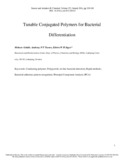JavaScript is disabled for your browser. Some features of this site may not work without it.
| dc.contributor.author | Golabi, Mohsen | |
| dc.contributor.author | Turner, Anthony P. F. | |
| dc.contributor.author | Jager, Edwin W. H. | |
| dc.date.accessioned | 2020-10-20T11:21:40Z | |
| dc.date.available | 2020-10-20T11:21:40Z | |
| dc.date.issued | 2015-09-08 | |
| dc.identifier.citation | Golabi M, Turner A , Jager E. (2016) Tunable conjugated polymers for bacterial differentiation. Sensors and Actuators B: Chemical, Volume 222, January 2016, pp. 839-848 | en_UK |
| dc.identifier.issn | 0925-4005 | |
| dc.identifier.uri | https://doi.org/10.1016/j.snb.2015.09.033 | |
| dc.identifier.uri | https://dspace.lib.cranfield.ac.uk/handle/1826/15905 | |
| dc.description.abstract | A novel rapid method for bacterial differentiation is explored based on the specific adhesion pattern of bacterial strains to tunable polymer surfaces. Different types of counter ions were used to electrochemically fabricate dissimilar polypyrrole (PPy) films with diverse physicochemical properties such as hydrophobicity, thickness and roughness. These were then modulated into three different oxidation states in each case. The dissimilar sets of conducting polymers were exposed to five different bacterial strains, Deinococcus proteolyticus, Serratia marcescens, Pseudomonas fluorescens, Alcaligenes faecalis and Staphylococcus epidermidis. By analysis of the fluorescent microscope images, the number of bacterial cells adhered to each surface were evaluated. Generally, the number of cells of a particular bacterial strain that adhered varied when exposed to dissimilar polymer surfaces, due to the effects of the surface properties of the polymer on bacterial attachment. Similarly, the number of cells that adhered varied with different bacterial strains exposed to the same surface, reflecting the different surface properties of the bacteria. Principal component analysis showed that each strain of bacteria had its own specific adhesion pattern. Hence, they could be discriminated by this simple, label-free method based on tunable polymer arrays combined with pattern recognition. | en_UK |
| dc.language.iso | en | en_UK |
| dc.publisher | Elsevier | en_UK |
| dc.rights | Attribution-NonCommercial-NoDerivatives 4.0 International | * |
| dc.rights.uri | http://creativecommons.org/licenses/by-nc-nd/4.0/ | * |
| dc.subject | Principal component analysis (PCA) | en_UK |
| dc.subject | Pattern recognition | en_UK |
| dc.subject | Bacterial adhesion | en_UK |
| dc.subject | Rapid microbial detection | en_UK |
| dc.subject | Polypyrrole | en_UK |
| dc.subject | Conducting polymer | en_UK |
| dc.title | Tunable conjugated polymers for bacterial differentiation | en_UK |
| dc.type | Article | en_UK |
Files in this item
The following license files are associated with this item:
This item appears in the following Collection(s)
-
Staff publications (SATM) [4368]

